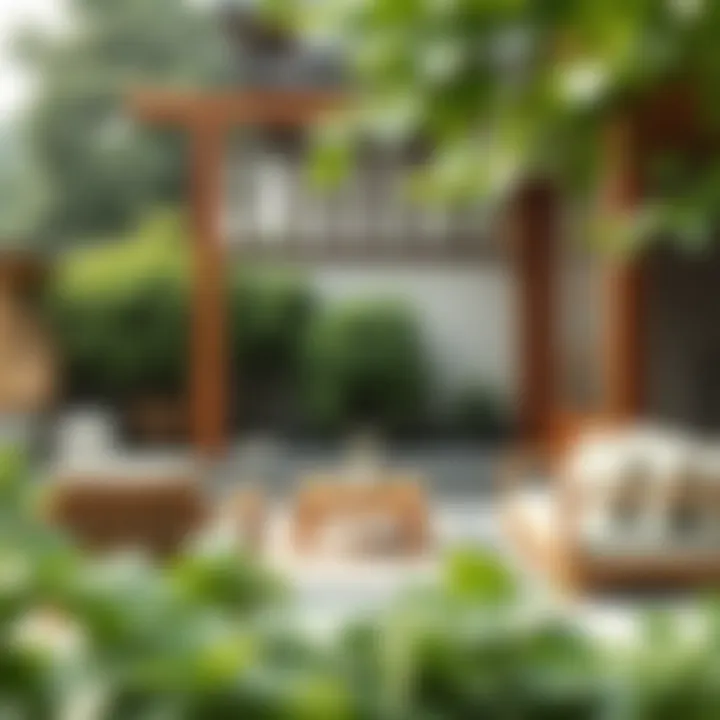Japanese Outdoor Furniture: A Harmonious Blend of Design


Intro
Japanese style outdoor furniture has captured the hearts of many, melding aesthetics with purpose. It draws from centuries-old traditions and reflects a deep respect for nature. Each piece isn’t just about functionality; it tells a story, evoking a sense of calm and simplicity that resonates in the hustle of modern life. This exploration aims to unravel these influences, showing how homeowners, designers, and DIY enthusiasts can incorporate these elements into their outdoor spaces.
Design Trends
Contemporary Styles
In today’s outdoor spaces, there’s a noticeable shift toward minimalist designs that prioritize clean lines and natural forms. Japanese outdoor furniture often embodies this, offering pieces that blend seamlessly with garden landscapes. Think of sleek teak benches with a soft finish or bamboo chairs that invite relaxation while hugging the curves of your patio. The emphasis is on functionality without unnecessary embellishments, allowing the surrounding environment to shine.
Focusing on essential elements can greatly enhance the charm of any space. Lasting impressions of sophistication come from selecting items that reflect airy and open designs, providing a physical and visual ease that promotes better atmosphere.
Vintage Inspirations
Conversely, the enchanting allure of vintage Japanese furniture still holds a significant place in outdoor design. These pieces often showcase intricate craftsmanship and elaborate joinery techniques, steeped in history and tradition. Timeless items like Shinto benches or folding tables create nostalgic connections, harkening back to meals shared under cherry blossoms or tranquil garden tea ceremonies.
Blending vintage pieces into modern settings can create an intriguing contrast. It evokes a feeling of continuity, merging the past with contemporary living.
"In every garden, there lies a poem waiting to unfold; each piece of furniture plays its part in this silent narrative."
Material Innovations
Sustainable Materials
Material choice in Japanese outdoor furniture often emphasizes sustainability. Traditional sources like bamboo offer durability and flexibility, while modern innovations spotlight recycled materials. For instance, composite wood blends natural fibers with recycled plastics, ensuring longevity while being eco-conscious. Such materials resonate well in an era fueled by environmental awareness, making them wise choices for contemporary consumers.
Investing in sustainable materials aligns not just with aesthetic values but also with a cultural respect for nature that Japanese design embodies.
Smart Furniture Technology
With the rise of technology, there’s also a budding trend in smart outdoor furniture. Incorporating features like solar-powered lights or mobile charging capabilities can enhance the outdoor experience. Furniture that integrates these elements harmonizes well with the Japanese ethos of merging nature with life. Imagine a wooden chaise lounge that illuminates softly at dusk or a dining table equipped with an ice compartment — these conveniences bring practical advantages to leisure activities.
Utilizing these advancements can elevate both comfort and functionality without sacrificing the essence of Japanese design. Integrating such tech-savvy solutions draws a direct line between ancient principles and modern needs.
Closure
As we journey through the nuances of Japanese style outdoor furniture, it’s evident that every detail matters. The synthesis of aesthetics with practical features not only enhances outdoor living but also pays homage to a rich cultural heritage. Whether you embrace contemporary styles or indulge in vintage inspirations, the key lies in making conscientious choices. By selecting thoughtfully crafted pieces, homeowners can create inviting spaces that resonate with serenity and style.
For a deeper understanding of Japanese furniture, resources like Wikipedia and Britannica offer valuable insights.
Prelude to Japanese Style Outdoor Furniture
Japanese style outdoor furniture represents more than just a collection of chairs and tables; it symbolizes a deep-rooted philosophy intertwined with nature, simplicity, and harmony. Understanding the essence of this furniture can greatly enhance both the aesthetic and functional aspects of any outdoor space. For homeowners, interior designers, and decorators alike, integrating Japanese-inspired elements is a journey toward creating relaxing environments that encourage interaction with the natural world.
The struggle between style and functionality often requires a keen eye to balance both effectively. Japanese design shines through here, as it elevates outdoor areas by infusing character while remaining practical. Benefits of this style include:
- Timeless Appeal: The aesthetics are not confined to fleeting trends.
- Connection to Nature: Encourages mindfulness and appreciation of natural surroundings.
- Versatile Applications: It caters to various preferences, from minimalist tastes to those incorporating intricate designs.
Defining Japanese Aesthetics
When delving into Japanese aesthetics, one must recognize the distinct facets that set it apart. Central to this concept is the principle of "Wabi-Sabi", which embraces imperfection and transience. Rather than pushing for perfection, Japanese design celebrates the beauty found in simplicity, making pieces resonate deeply with those who seek tranquility.
Elements such as clean lines, neutral palettes, and natural materials dominate this style, leading to a feeling of calm and order. Common characteristics of Japanese outdoor furniture include:
- Organic Shapes: Resembling forms found in nature, which allows for a fluid transition between indoor and outdoor spaces.
- Low Profiles: Furniture often sits close to the ground, creating an unfussy, grounded vibe that encourages relaxed interactions.
- Subtle Textures: Scratchy bamboo or smooth teak finishes offer sensory experiences that draw you deeper into restful outdoor moments.
This emphasis on simplicity and nature-induced materials positions Japanese style outdoor furniture as a preferred choice for those keen on creating serene outdoor sanctuaries.
Historical Context
To truly appreciate Japanese outdoor furniture, we must consider its historical backdrop. The relationship between people and nature has been a prominent theme in Japanese culture for centuries. Most notably, traditional Japanese homes, surrounded by gardens, utilize various aspects of their surroundings, seamlessly integrating indoor and outdoor areas.
The influence of Zen Buddhism led to the development of functional yet elegant designs that reflect a deep respect for craftsmanship and nature. Historically, furniture was not merely for sitting; it served as a bridge between the environment and the living space. This profound understanding was shaped by nature’s aesthetics and spirituality stemming from Shinto beliefs.
Key historical factors include:
- Tea Ceremony Traditions: These rituals emphasized minimalism and appreciation for the moment, shaping outdoor arrangements to complement such practices.
- Role of Craftsmanship: Skills passed down through generations have led to superior quality and durability, with artisans honing their work using traditional techniques.
Incorporating furniture that mirrors this historical significance allows modern users not only to furnish their outdoor spaces but also to engage with a culture rich in meaning.
Key Design Principles


Japanese style outdoor furniture is not merely a matter of aesthetics; it represents a philosophy deeply embedded in its design principles. These principles—simplicity, the integration of natural elements, and an emphasis on harmony and balance—are fundamental to understanding why this furniture style resonates so profoundly with those who appreciate both beauty and functionality.
Simplicity and Minimalism
One of the most defining characteristics of Japanese outdoor furniture is its simplicity. In this context, simplicity isn't about lacking features; rather, it speaks to a refined approach that emphasizes clean lines, uncluttered spaces, and intentional design. Minimalism echoes the idea that "less is more," allowing the eye to appreciate the craftsmanship and the natural beauty of the materials without distraction.
For instance, many Japanese benches or tables are crafted from single pieces of wood or clay, featuring smooth surfaces and natural grain. This emphasis on the essence of materials creates an engaging tactile experience. The design invites individuals to slow down and engage with the furniture, fostering a deeper connection to the outdoor environment. This approach is ideal for homeowners looking to create tranquil outdoor spaces where they can escape the chaos of daily life.
Natural Elements Integration
Integrating nature into outdoor spaces is a hallmark of Japanese design philosophy. This is not just about using natural materials like wood or stone; it's about making furniture that feels like a natural extension of its surroundings. A common practice involves carefully selecting wood types that blend well with the landscape, ensuring that each piece becomes part of the tapestry of the garden or patio.
Bamboo, for example, not only stands strong against the elements but also adds a touch of warmth and organic beauty to an outdoor area. Similarly, cedar furniture, known for its aromatic qualities and durability, synchronizes with nature by emitting a subtle scent that enhances the outdoor experience.
When integrating furniture with its surroundings, consider how the furniture's shape, color, and texture relate to what’s around it. Just as a river flows gently through a valley, so too should furniture sit harmoniously within a garden or outdoor setting. In many respects, the furniture should tell a story about the environment and the moments experienced within it.
Harmony and Balance
Another fundamental principle is achieving harmony and balance in design. Japanese outdoor furniture is crafted with an intuitive understanding of balance—between light and heavy, open and enclosed, individuality and unity. This principle can be illustrated through the careful placement of pieces in outdoor spaces. For instance, a sturdy, simple table can be complemented with lighter, more delicate chairs to create visual balance.
In addition, furniture design often focuses on proportion. A large piece shouldn’t overwhelm a small garden; rather, it should complement and enhance its surroundings. When you walk into a space, your eye should naturally travel across the surface of the furniture and the landscape, creating a sense of unity and peace.
"Balance creates a sense of tranquility. In a space designed with harmony, function feels effortless."
Choosing pieces that embody these principles not only enhances the visual appeal but elevates the entire outdoor experience. Homeowners and designers keen on achieving this zen-like ambiance typically invest time into selecting furniture that embodies these ideals.
In summary, the key design principles of simplicity, natural elements, and harmony should guide anyone looking to incorporate Japanese outdoor furniture into their spaces. These elements serve as critical points of consideration, ensuring that each piece is not merely functional but an integral part of a larger, cohesive narrative in the outdoor environment.
Materials Commonly Used
In the realm of Japanese style outdoor furniture, the choice of materials plays an essential role. The significance extends beyond aesthetics; it encompasses functionality, durability, and a profound connection to nature. Selecting the right materials can either enhance the beauty of an outdoor space or detract from its serene atmosphere.
The materials used in crafting this style of furniture are deliberately chosen for their natural properties. Wood, metal, and textiles each bring a unique essence and can either mimic or complement the surrounding environment. With a focus on sustainability, Japanese outdoor furniture often utilizes materials that age gracefully and require minimal maintenance.
Wood Types
Cedar
Cedar stands out for its appealing scent and natural resistance to decay. One of the most striking characteristics of cedar is its ability to withstand the elements, making it a popular choice for outdoor settings. The natural oils present in cedar help to repel insects and moisture, thus prolonging its lifespan.
A unique feature of cedar is its striking visual appeal. The rich reddish hue and fine grain patterns create an eye-catching aesthetic that blends seamlessly with any garden or patio. However, it is worth noting that cedar may require regular treatment to maintain its color and prevent weathering. Despite this, its longevity and natural beauty make it a beneficial choice for Japanese outdoor furniture.
Bamboo
Bamboo, often referred to as a grass rather than a wood, offers a lightweight yet strong alternative. Its rapid growth makes it an environmentally friendly option; a distinct characteristic that resonates with eco-conscious homeowners. The versatility of bamboo allows for both structural and decorative applications in furniture.
The unique features of bamboo include its resilience and flexibility, which can be harnessed for innovative designs. However, its vulnerability to pests and humidity poses some challenges. Without proper treatment, bamboo furniture might wear faster than other materials. Still, for those pursuing a blend of style and sustainability, bamboo can be an exciting choice.
Teak
Teak is another heavyweight in outdoor furniture, admired for its incredible durability and luxurious appearance. The high oil content of teak makes it resistant to water damage and unwanted pests, which makes it well-suited to outdoor environments. One distinguishing aspect of teak is its ability to develop a beautiful silver-grey patina over time—something many furniture enthusiasts appreciate.
While teak’s weight can sometimes be a drawback, it provides stability that is necessary for larger pieces. Maintenance-wise, it does require periodic oiling to preserve its original color, but this adds to the allure of teak furniture. Its timeless appeal and exceptional durability clearly make it a popular choice in crafting Japanese-style furniture.
Metal Elements
Aluminum
Aluminum provides a practical counterpart to traditional wooden pieces. It's light, resistant to rust, and can be molded into various shapes, making it a versatile choice for modern interpretations of Japanese design. Its lightweight nature means that outdoor furniture can easily be rearranged to suit different occasions.
A crucial advantage of aluminum is its ability to endure harsh weather conditions, making it suitable for various climates. However, while it’s durable, it may not carry the same warmth as wood. Still, its sleek lines can offer a contemporary twist that complements classic designs.
Steel
When discussing strength and durability, steel often takes the crown. Like aluminum, it's highly resilient to outdoor elements. Steel can endure heavy use, which is why it’s often found in commercial outdoor furniture. Adding a finish can elevate its appearance, allowing it to fit well within a Japanese aesthetic.
Some say steel can lack the organic warmth of wood but its sleek design can impart a modern elegance that's hard to ignore. It's essential to ensure proper care, as untreated steel may rust over time. But when well-maintained, steel pieces can serve as lasting fixtures in any outdoor setting.
Textiles and Cushions
Weather Resistant Fabrics


Incorporating textile elements into Japanese outdoor furniture enhances comfort while retaining the overall design ethos. Weather-resistant fabrics are crucial for outdoor furnishings, shielding them against sun and rain damage. These fabrics are typically treated to ensure they resist fading and staining.
The softness and touch of high-quality weather-resistant fabrics invite relaxation, making the furniture more inviting. However, one must consider the trade-off as some may retain heat and become uncomfortably hot in direct sunlight. Yet, the ability to combine comfort and resilience makes these fabrics a natural choice for outdoor settings.
Natural Fibers
Natural fibers bring a touch of warmth to outdoor settings, connecting occupants to the environment. Fabrics made from materials like cotton or linen can complement wooden furniture elegantly. They are breathable and often provide a cozy feel.
However, there are vulnerabilities associated with natural fibers; they may not fare well in intense weather conditions without proper treatment or care. Despite this, they are highly aesthetically pleasing and can transform a simple piece into a work of art. Ultimately, the choices made in textiles can either enhance or detract from the serene ambiance typically sought in Japanese outdoor design.
A thoughtful selection of materials not only influences practicality but also underlines a commitment to the philosophical underpinnings of Japanese aesthetics, where nature and humanity coexist harmoniously.
Craftsmanship and Artistry
When delving into the realm of Japanese style outdoor furniture, craftsmanship and artistry serve as the backbone of its success. The beauty of outdoor pieces is not just skin deep. It's about the careful selection of materials, the profound techniques used, and the dedication poured into every single detail. For the discerning homeowner or interior designer, understanding these elements can transform a mere outdoor space into an immersive experience, rich in culture and appreciation for nature.
Traditional Techniques
The essence of traditional craftsmanship in Japanese furniture lies in its attention to detail. Craftsmen often employ age-old methods passed down through generations. One technique prevalent in Japan is Kintsugi, the art of repairing broken pottery with gold lacquer. This philosophy extends into furniture making where imperfections are celebrated rather than hidden. Here are some traditional methods that reflect this unique philosophy:
- Hand Polishing: Every surface is meticulously refined to enhance the natural grain of wood, particularly for types like cedar and teak.
- Natural Finishes: Finishes are often derived from natural sources, ensuring that the furniture remains eco-friendly and aesthetically pleasing. Oil from plants, for instance, is used to protect the wood while allowing it to age gracefully.
- Dovetail Joints: This method offers both strength and beauty, showcasing the harmony between functionality and aesthetics.
Incorporating these techniques results in furniture that is not only functional but serves as a work of art that commands admiration. Craftsmanship is evidently a labor of love, capturing the soul of Japanese traditions and inviting them into your outdoor spaces.
Influence of Japanese Joinery
Japanese joinery is a remarkable craft. Unlike Western carpentry, which often relies heavily on screws and nails, Japanese techniques create strong connections through precision cuts and interlocking parts. This method of construction highlights several advantages:
- Durability: Joinery allows for expansion and contraction, making it particularly resilient against the changing weather conditions.
- Ease of Repair: If a piece marginally suffers from wear and tear, its robust construction permits straightforward repairs without compromising integrity or visual appeal.
- Simplicity in Design: The seamlessness of the result often leaves an elegant profile that suits various outdoor settings. The clean lines often described are a hallmark of minimalist Japanese aesthetics.
The art of joinery, much like the craft itself, embodies a respect for the materials and the environment. It reflects a philosophy of making furniture that not only serves a purpose but also honors its surroundings, contributing to the natural beauty of outdoor spaces.
"Craftsmanship is not just about the object made; it's about telling stories through every cut, every joint, and even in the silence of unspoken beauty."
In blending these traditional techniques with contemporary styles, homeowners can create outdoor environments that evoke tranquility and foster connection with the natural world. The marriage of craftsmanship and artistry plays a vital role in ensuring that Japanese-style outdoor furniture remains both functional and beautiful.
Selecting the Right Pieces
Choosing the perfect outdoor furniture is much like putting together a puzzle. Each piece needs to fit not just physically, but aesthetically and functionally as well. Japanese style outdoor furniture embodies this balance, offering elegance while remaining practical. The right selections enrich both personal enjoyment and overall design coherence, making it vital for homeowners, designers, and decor enthusiasts to consider various factors before making their choices.
Assessing the Outdoor Space
Before diving into specific pieces, one must take a step back and assess the outdoor environment. It’s all about context here. Take a good look at the size of your space. Are you working with a sprawling garden or a compact balcony? The dimensions could dictate the style and scale of the furniture you select.
- Proximity to Nature: Analyze how integrated your space is with surrounding nature. This might affect the materials you choose, leaning towards organic textures like wood or bamboo that reflect the outdoors.
- Sun and Shade: Check where sunlight hits during the day. Some pieces do better in full sun while others are meant for shaded areas. Consider how exposure might affect longevity, especially with natural wood types like cedar or teak.
- Landscape Features: Consider existing landscape elements like trees or pathways. Make sure your furniture complements these features rather than clashes with them.
Doing this first step right helps in ensuring that your choices won’t just be beautiful but also practical in the given setting.
Purpose and Functionality
Next comes the question of purpose. What do you want your outdoor space to achieve? A tranquil retreat? A lively place for gatherings? Or perhaps a mix of both?
- Social Gatherings: If you plan on hosting friends and family, opt for larger dining sets or sectional seating arrangements that encourage conversation and togetherness. Consider how many individuals typically gather and select pieces that provide adequate seating.
- Relaxation Areas: For quiet afternoon retreats, a couple of lounge chairs or a swinging daybed may suffice. Think about personal comfort – does the furniture promote relaxation?
- Multi-purpose Items: Look at options that serve more than one function, like benches that double as storage for cushions. This increases efficiency and contributes to a tidy space.
By aligning your furniture selection with your intended use, you create an outdoor setting that meets your needs seamlessly.
Personal Style Considerations
Last but certainly not least, is the aspect of personal style. Your outdoor area should tell your story and reflect your tastes. Think about the following key points:
- Color Palette: How do the colors of your outdoor furniture resonate with the shades present in your home and garden? Opt for neutrals or soft tones that promote a calm ambiance, commonly seen in Japanese aesthetics.
- Design Cohesion: Ensure that your selected pieces meld well together. This might involve choosing furniture that shares similar lines, materials, or design philosophies. Striking that balance between contemporary flair and traditional elements is a compelling exercise in cohesion.
- Cultural Resonance: If you’re a lover of Japanese culture, this can play a crucial role. Look for specific types of pieces that echo your love for Zen decor or traditional craftsmanship, whether it’s a wooden bench reminiscent of a Japanese garden or cushions hand-crafted with natural fibers.
Personal style should be at the heart of your choices while still considering overall harmony within the space.
"The right pieces can transform any outdoor area, turning it into an extension of your home and a reflection of your uniqueness."
Incorporating Japanese Design in Modern Settings
The incorporation of Japanese design in modern outdoor settings is a reflection of how traditional aesthetics can coexist harmoniously with contemporary lifestyles. For many homeowners and designers, embracing this style isn't merely about adding furniture; it’s a journey into creating a holistic environment where nature and structure align. Japanese outdoor furniture promotes serenity, encouraging relaxation and connection to the natural world. It embodies a set of principles that prioritize simplicity, functionality, and an appreciation of craftsmanship, all of which can enhance modern living spaces.
Blending Traditional with Modern


When discussing the blend of traditional Japanese elements with modern aesthetics, it’s essential to recognize the unique dialogue that occurs between these two styles. For instance, the clean lines and organic shapes typical of Japanese design can soften the harshness often found in modern architecture.
- Proportions and Scale: Choosing furniture pieces that respect the scale of the outdoor environment allows the design to breathe. Think about a low-slung Japanese-style bench resting comfortably under a broad tree, offering a cozy gathering spot.
- Material Choices: Incorporating natural materials such as untreated wood finishes alongside sleek metal accents embodies a union of the old and new. A wooden table paired with metal chairs can create a stylish contrast, merging functionality with tradition.
- Color Palette: Soft, earthy hues reminiscent of nature help bridge the gap. Shades of bamboo, beige, and muted greens can dominate the space while maintaining a modern flair.
One might often find furniture made from sustainable materials, reflecting both a commitment to environmental consciousness and a return to traditional Japanese values. Adopting this blend lets individuals express their style while also harnessing the benefits of durability and sustainability.
Creating Zen Spaces
In today’s fast-paced world, the need for tranquil spaces is more pronounced than ever. An outdoor area designed with Japanese principles can transform an ordinary setting into a personal zen sanctuary. The key to achieving this lies in an intentional approach to layout and design.
Picture a modest patio bordered by rocks and gravel, accented with softly cascading plants. Here are some guiding principles for crafting a zen-like outdoor area:
- Natural Elements: Integrate water features like small ponds or even bamboo fountains to create soothing sounds that inspire calmness. Water is seen as a purifying element in Japanese culture, enhancing serenity.
- Strategic Plant Placement: Utilize stones, shrubs, and trees, employing asymmetrical arrangements. These organic layouts reduce chaos and foster a sense of peace.
- Functional Furniture: Select pieces that not only fit the aesthetic but serve a purpose. A low wooden table can act as a resting place for tea ceremonies, encouraging mindful practices.
Practicing mindfulness in a thoughtfully designed space cannot be overstated. It invites moments of reflection, rejuvenating one’s spirit.
By focusing on these elements, homeowners and designers can conjure a tranquil atmosphere that complements the hustle of modern living, helping to establish a deeper connection with nature and oneself.
Maintenance and Care
Caring for Japanese style outdoor furniture is a crucial aspect that goes hand in hand with its aesthetic appeal. This style not only enhances one’s outdoor space but also embodies an ethos of sustainability and harmony with nature. Proper maintenance can enable these structures to last through seasons, preserving both beauty and functionality. Here, we delve into vital practices that should be adopted, ensuring that the furniture remains in excellent condition for years to come.
Wood Preservation Techniques
Wood, often the heart of Japanese outdoor furniture, needs the right touch to stand the test of time. Preserving wooden pieces is akin to nurturing a delicate plant—it requires diligence and attention. Here are some effective strategies for wood preservation:
- Regular Cleaning: Simple yet fundamental. Dust and dirt can cause wear over time. A soft cloth or a brush can work wonders in keeping the surface clean and maintaining a polished look.
- Sealing and Staining: Applying a sealant or stain can help protect the wood from moisture and UV rays. Choosing a product that is compatible with the type of wood being used is essential. For instance, teak often benefits from a specific teak oil that brings out its rich color while safeguarding against the elements.
- Inspection: Periodic checks for signs of wear, such as cracks or warping, can prevent bigger issues down the line. When caught early, minor fixes might save both time and money.
- Storing in Off-Season: If possible, it’s wise to store wood furniture indoors during harsh weather. This practice minimizes exposure to snow, rain, and excessive heat, all of which can be detrimental.
These methods can significantly extend the lifespan of wooden structures, making sure they remain inviting and functional.
Cushion and Fabric Care
Outdoor cushions and fabrics deserve careful attention as well. While they enhance comfort and visual appeal, maintaining them can be somewhat of a task. Here’s how to keep them looking spick and span:
- Routine Cleaning: Just like dusting furniture, cushions need a good scrubbing. A solution of mild soap and water can be effective. A soft brush can help remove stubborn stains without damaging the material.
- Weather Treatments: Using water-repellent sprays can provide an extra layer of protection against moisture. Many modern fabrics are already made to be water-resistant, but a spray can enhance this feature.
- Storage Practices: When not in use, storing cushions in a dry, sheltered environment can help them avoid mildew. Utilizing breathable bags or containers can preserve their shape and color.
- Sunlight Exposure: Too much sunshine can fade colors. If the space allows it, consider rotating the cushions or changing their arrangement to limit sun exposure on a single side.
Implementing these care steps not only enhances the longevity of cushions but also ensures that the overall ambiance of the space remains serene and inviting.
"With proper care, your Japanese style outdoor furniture can reflect beauty and resilience, mirroring nature’s own artistry."
In essence, maintaining Japanese outdoor furniture is about embracing a lifestyle in sync with the environment. This attention to detail goes beyond mere aesthetics; it is a testament to respect for craftsmanship and the materials used.
Cultural Significance of Outdoor Furniture
The role of outdoor furniture in Japanese culture goes beyond mere functionality; it embodies a deeper connection to nature and community values. By understanding how these pieces serve as a bridge between the domestic realm and the natural world, we can appreciate their importance in both historical and modern contexts.
Connection to Nature
In Japan, the concept of nature is interwoven with daily life. Outdoor spaces are not just extensions of homes, but they seamlessly integrate the essence of the environment. Furniture designed for these outdoor areas often reflects natural forms, using materials and structures that mimic the simplicity and beauty of nature. The idea is to create a tranquil space that allows for reflection and relaxation.
- Natural Integration: Japanese outdoor furniture is crafted to harmonize with the landscape, enhancing rather than overshadowing the surroundings. For instance, a simple wooden bench placed amid blooming cherry trees encourages individuals to engage with the changing seasons, offering a visual feast that's resonant with the idea of 'mono no aware'—the beauty of impermanence.
- Mindful Interaction: The outdoor space, furnished with thoughtful pieces, cultivates a relationship with nature. The act of sitting in a garden on a handcrafted table can lead to an appreciation of the sounds of birds or the rustle of leaves, fostering a sense of serenity amidst the bustling noise of everyday life.
This intrinsic bond with nature is not merely aesthetic but serves a practical purpose, aligning with traditional Japanese philosophy that emphasizes sustainability and respect for the environment.
Social Gatherings and Community
Outdoor furniture in Japan also plays a significant role in fostering community bonds. The spaces created by these furnishings become venues for social interactions and gatherings—an integral aspect of Japanese culture that emphasizes connection and togetherness.
- Gathering Spaces: Whether it’s a family barbecue or a neighborhood tea ceremony, well-designed outdoor areas equipped with comfortable seating encourage communal activities. The use of tatami mats or low tables adapted for outdoor settings allows people to sit close, share food, and engage in meaningful conversations, highlighting the importance of companionship.
- Festivals and Events: Numerous festivals celebrate the beauty of the outdoors, and the furniture used during these events reflects traditional designs. For instance, at hanami (flower viewing) parties, handcrafted seating arrangements invite participants to enjoy the fleeting beauty of cherry blossoms together, reinforcing social ties.
By embracing these cultural nuances, the significance of outdoor furniture becomes evident. It's not just about aesthetics; it's about creating spaces that foster relationships, respect for nature, and a sense of belonging.
"Japanese outdoor furniture is not merely functional; it embodies a cultural ethos that cherishes nature and nurtures community connections."
Finale
In wrapping up our discussion on Japanese style outdoor furniture, it’s essential to emphasize the multiple benefits that arise from integrating this aesthetic into our living spaces. At its core, Japanese outdoor furniture exemplifies a unique marriage of beauty and functionality. Homeowners today are increasingly drawn to the fluidity of these designs that not only enhance the visual appeal of outdoor areas but also create a serene environment that speaks to a lifestyle centered around mindfulness and harmony with nature.
Summarizing the Impact of Japanese Design
Japanese design, in its essence, encourages simplicity and a clear connection to the natural world. This cultural ethos allows homeowners to cultivate spaces that resonate with peace and tranquility. Here's a closer look at the broad impacts of this style:
- Emphasis on Natural Materials: The use of materials like bamboo, cedar, and natural stone not only champions sustainability but also ensures that each piece ages beautifully, developing character over time.
- Functional Aesthetics: The intelligent design of Japanese furniture often features unobtrusive lines and understated elegance, making it not just pleasing to the eye but remarkably functional for outdoor living.
- Promoting an Outdoor Lifestyle: By integrating Japanese outdoor furniture, one can create inviting spaces for social gatherings, fostering a deeper connection among family and friends in a natural setting.
- Cultural Awareness: Opting for this style also opens a window into Japanese culture, allowing users to appreciate the philosophy behind such design choices, which stress a balance between form and function.
Let’s not forget the delicate balancing act between traditional craftsmanship and modern utility that Japanese furniture embodies. The future of outdoor spaces is bright with the inclusion of these elements, as they continually adapt to changing lifestyles while maintaining a strong nod to their roots.
In summary, the true beauty of Japanese outdoor furniture lies not only in its aesthetic appeal but also in its capacity to enhance lifestyle through thoughtful design and artistry. As we embrace these principles, we cultivate environments that promise serenity, social connection, and a meaningful respect for nature.















